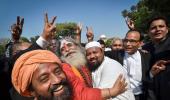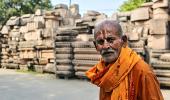The following are the highlights of the Supreme Court judgment in which it unanimously granted the entire 2.77 acre of the disputed Ram Janambhoomi-Babri masjid land in Ayodhya to deity Ram Lalla.

- Possession of disputed land will be handed over to the deity Ram Lalla, one of the three litigants in the case
- The land will remain with a central government receiver
- The disputed site was government land in the revenue records
- SC directs allotment of alternative land to Muslims to build new mosque
- Suitable land of 5 acres to be handed over to Sunni Waqf Board at prominent place for building the mosque
- Centre to frame scheme within 3 months and set up a trust for construction of a temple
- SC dismisses plea of Nirmohi Akhara seeking control of entire disputed land.
- Centre, UP govt can monitor together future actions by authorities
- SC asks the Centre to grant representation in the trust to Nirmohi Akhara if deemed fit by the government.
- SC holds that Nirmohi Akhara's suit is barred by limitation, not a shebait or devotee of deity Ram Lalla
- Ram Janambhoomi is not a juristic person
- Babri mosque, demolished on December 6, 1992, was not built on vacant land
- SC says that terming the archaeological evidence as merely an opinion would be a great disservice to the ASI
- Fact that there lay a temple beneath the destroyed structure has been established by the ASI, says SC
- The underlying structure was not an Islamic structure
- ASI had not established whether temple was demolished to build the mosque
- Hindus consider this place as birthplace of lord Ram, even Muslims say this about disputed place
- Faith of Hindus that Lord Rama was born at demolished structure is undisputed
- The existence of Sita Rasoi, Ram Chabutra and Bhandar Grih are the testimony of the religious fact of the place
- Evidence suggests Hindus were in possession of outer court yard.
- Extensive nature of Hindus worshipping at outer courtyard at site has been there
- Evidence suggest Muslims offered Friday prayers at mosque which indicates they have not lost possession
- Despite obstruction caused in offering prayers at Mosque, evidence suggest that there was no abandonment
- Iron railing was set up at site in 1856-1857, it suggests Hindus kept worshipping at the site
- Title cannot be established on ground of faith, belief;they are kind of indicator for deciding dispute.
- Muslims have not adduced evidence they were in exclusive possession of dispute site
- Muslims were not in possession of outer courtyard of the site
- UP Sunni Central Waqf Board has failed to establish its case in Ayodhya dispute
- On the contrary, Hindus established their case that they were in possession of outer courtyard
- Damage to Babri mosque was violation of law
- 5-judge Constitution Bench which delivered the verdict comprised Chief Justice Ranjan Gogoi and Justices S A Bobde, D Y Chandrachud, Ashok Bhushan and S Abdul Nazeer
- Pronouncement of the verdict, which commenced at 10:30 am, went on for 45 minutes
- 14 appeals were filed in SC against the 2010 Allahabad high court judgment, delivered in four civil suits, that the 2.77-acre land in Ayodhya be partitioned equally among the three parties -- the Sunni Waqf Board, the Nirmohi Akhara and Ram Lalla
- Initially, as many as five lawsuits were filed in the lower court. The first one was filed by Gopal Singh Visharad, a devotee of ''Ram Lalla'', in 1950 to seek enforcement of the right to worship of Hindus at the disputed site
- In the same year, the Parmahansa Ramachandra Das had also filed the lawsuit for continuation of worship and keeping the idols under the central dome of the now-demolished disputed structure
- The plea was later withdrawn.
- The Nirmohi Akhara moved the trial court in 1959 seeking management and ''shebaiti'' (devotee) rights over the 2.77 acre disputed land
- Then came the lawsuit of the Uttar Pradesh Sunni Central Wakf Board which moved the court in 1961, claiming title right over the disputed property
- The deity, ''Ram Lalla Virajman'', through next friend and former Allahabad high court judge Deoki Nandan Agrawal, and the Janambhoomi (the birthplace) moved the lawsuit in 1989, seeking title right over the entire disputed property on the key ground that the land itself has the character of the deity and of a ''juristic entity''
- All the lawsuits were transferred to the Allahabad high court for adjudication following the demolition of the disputed Ram Janambhoomi-Babri masjid structure on December 6, 1992, sparking communal riots in the country
- The SC on August 6 commenced day-to-day proceedings in the case as the mediation proceedings initiated to find the amicable resolution had failed
- The bench on October 16 had reserved the judgment after a marathon hearing of 40 days











 © 2025
© 2025